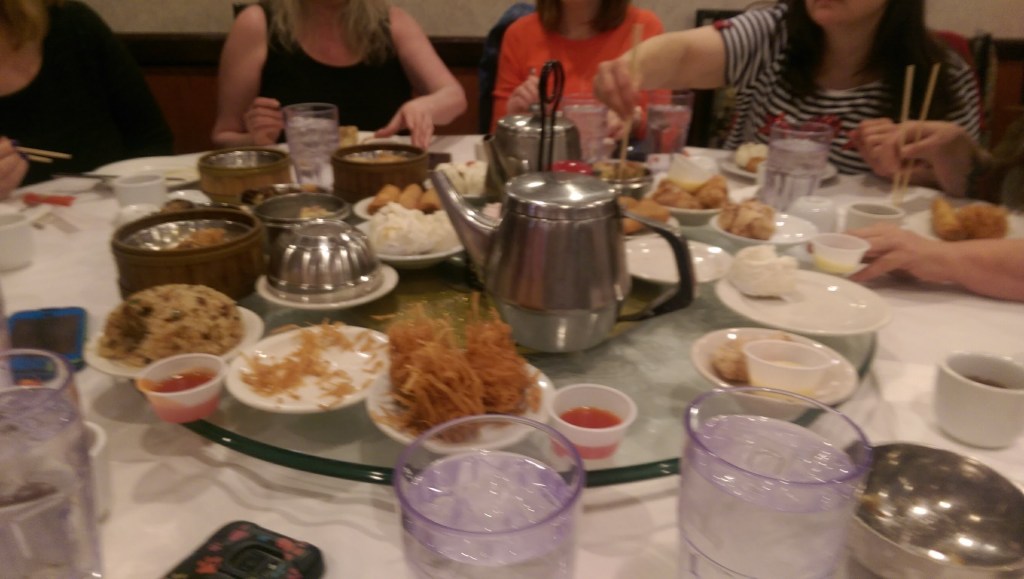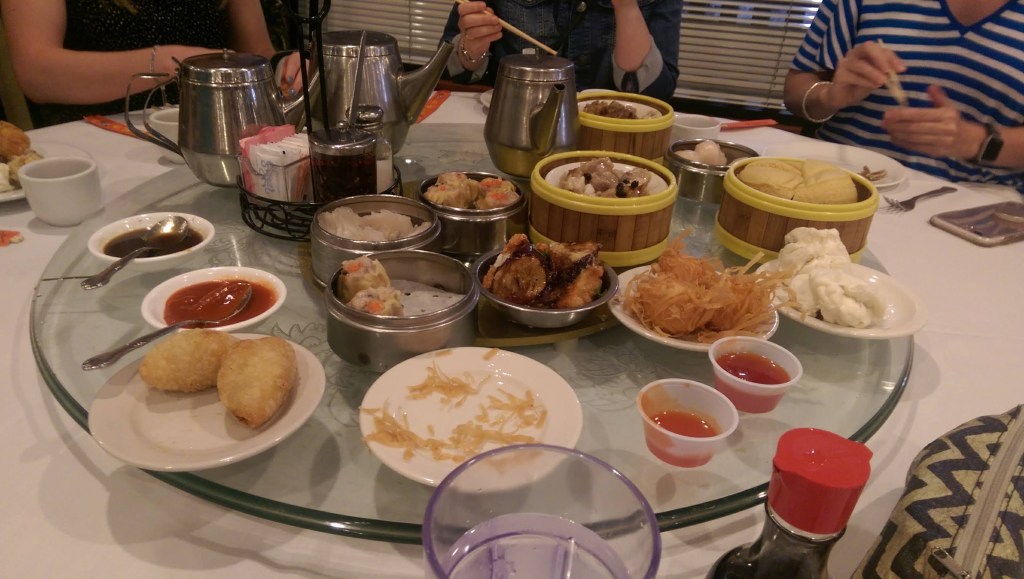As most of my long-time readers know, one of my favorite meals is going out for dim sum with friends. Li Wah has been one of my favorite places because it has the dim sum served from carts. Dim sum (otherwise referred to as Yum Cha) is considered to be brunch in the Far East. Dim sum is usually served for breakfast and lunch (10am – 3pm at Li Wah). The baked, fried, or steamed goods usually come with 3 or 4 pieces to an order. Dishes are expected to be shared. Asians consider the concept of ”that plate is yours and this plate is mine” as impolite. Sharing is essential to developing a better relationship with your friends and family. Dim sum carts roll past every table throughout the restaurant, and guests can pick from different dim sum items as the carts roll by. You generally just point at what you want and/or nod if you recognize the name of the item. Shumai are always a good place to start – or the black bean spare ribs.
 |  |  |
Tea is considered to be an essential part of the dim sum experience. The Cha in Yum Cha stands for tea. Tea is automatically served when you are seated, and you are expected to serve your dining companions before serving yourself. Li Wah carries 6 different blends of tea. The tea charge varies from .80 cents per person to 1.00 per person depending upon tea selection. I like the basic oolong they serve, but you can also order jasmine tea or chrysanthemum tea (which are made with actual chrysanthemum blossoms. When your tea pot is empty or needs to be refreshed, simply leave the teapot lid open. They also serve beer, wine, various cocktails, sodas, lemonade with popping pearls, milk tea, bubble tea and smoothies. But if you are splitting the bill in the end it might be a good idea to order them separately.
 |  |  |
 |  |  |
My favorite dim sum items at Li Wah are primarily dumplings as well as the steamed buns with Peking duck, the shrimp, Har Gow and tofu skin rolls. Chinese people have been raised on a diet of predominately pork, poultry (duck and chicken), and seafood. Many Asians are lactose intolerant due to the lack of cows in the region. Roast duck, Peking duck, and roast pig are wonderful meats to try, but they tend to be expensive additions. Likewise, the Chinese vegetables such as Chinese broccoli (Gai Lan), bok choy, pea pod leaves (dao mu), or Bittermelon (Foo Gaw) can be expensive additions as well and take longer to make so order them early if you want some greens with your dumplings. I can also recommend the cucumber salad.
The weekends tend to be the busiest, and they tend to roll out some of the better items later in the day like the mussels or salt baked prawns. The more adventurous eaters might want to try the chicken feet or the tripe or jellyfish, but I tend to order the less adventurous things when I am dining out with friends who are new to dim sum. It helps that I am not the biggest fan either.
If you have a larger group it is a good idea to make sure you get a table with a rotating glass lazy susan. It’s a good idea to have one of the more experienced diners be in charge of ordering and in charge of the bill, because otherwise chaos ensues. As the items are set on the table, the server will mark it on your bill depending on the price of the item.
Most dim sum are served as three or four to a plate. It’s also good to order enough so each person either gets their own bite-sized item or cut the item in half with a chopstick or fork. Knives are considered bad energy, a cutting force, in feng shui. It is not proper to eat a Chinese meal with a knife and fork. If you can’t handle chopsticks, use a spoon and a fork. Li Wah can also give you children’s chopsticks, which are held together with a rubber band. The Chinese don’t cut food on the table – although we have been brazen in the past and asked for a knife. If you want something like the turnip cakes cut up into smaller servings the server will be happy to do so for you. But using a knife to cut up the dim sum really is frowned upon.
The desserts are sweeter dim sum as shown above. It’s a good idea to order one or two items like the mango pudding, egg tarts or my favorite egg custard bun for a sweet ending. Even the sesame balls (the round balls coated with sesame seeds in the center of the photo on the right) can be considered sweeter because the red bean paste filling is sweeter than some of the savory items.
 |  |  |
Once everyone is full (which is easy to do) you ask one of the servers to total up your bill and then you divide it by however many diners were at the table. It is best to make sure everyone has enough cash to cover themselves and then just hand the cash to the server. Too many credit cards can throw the server off their game. I have an app that calculates the tip (Li Wah is now tacking on an automatic gratuity of 18% though, so be sure to doublecheck whether the tip is already included) and divides the total by the number of diners. Most of the time we end up paying $20-25 a person (unless a roast meat or vegetable dish has been ordered, then it is more like $30). Unfortunately the price per item has risen in the last few years, and the quality has become hit or miss. Nevertheless, it’s still a fun experience that everyone should have at least once, and it’s a great way to share a meal with friends.
 |  |
Contact info:
Li Wah
2999 Payne Avenue, Suite 102
Cleveland, OH 44114
(216) 696-6556





